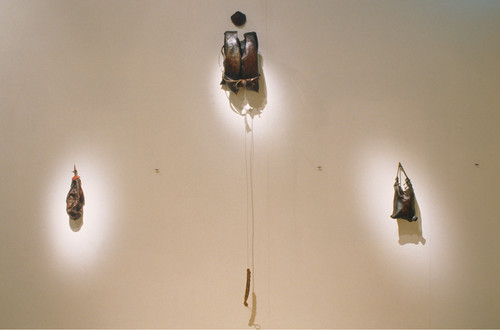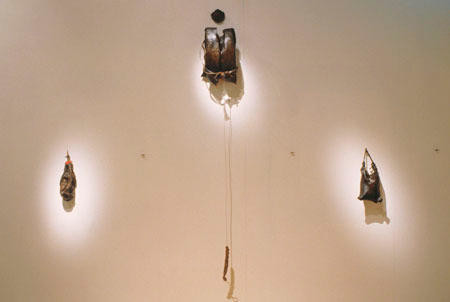B.
Flottage by Carolyn Menzies
Collection
Flottage, by expatriate New Zealand artist Carolyn Menzies, hangs on the gallery wall as if washed up by the last tide.

Carolyn Menzies Flottage 1995. Mixed media. Collection of Christchurch Art Gallery Te Puna o Waiwhetū, purchased 1995. Reproduced with permission
This intriguing sculpture is made from bull kelp collected by the artist from beaches in the South Island and fashioned to resemble a breathing apparatus that simultaneously speaks of the merciless depths of the ocean, diving and medical paraphernalia. The brown bull kelp, specific to New Zealand, locates this work within an island context, combining notions of isolation with an inescapable dependence on the environment for survival. The installation could represent a collection of flotsam and jetsam, or perhaps it represents a deeper, more enigmatic, application of life-support systems waiting to be used. Flottage incorporates imagery related not only to the ocean, but to the absence and presence of the body, its fluidity, weaknesses and strengths juxtaposed with a technological world.
The ebb and flow of tides and the residue washed up from the Pacific Ocean have become metaphors for life, death, illness and loss in this sculpture, as water is both a dangerous threat and a source of life. Menzies has intertwined the natural and organic with a commentary on the evolution of technology and how it impacts on human existence. This life-support system has been molded from the artists own body and sewn into an aquatic lung, a breathing mask and life jacket, but the body is only alluded to through its absence. Menzies washed the seaweed to remove mucus and general debris then hung it on drying racks in her studio. The kelp was kept moist and pliable in order for it to assume the shapes of her body and hand-stitched to keep its form. Although moist when collected from the beach, the kelp has now shrunk and shrivelled like skin, drained of fluid and holds the imprint or trace of her body. This work is extremely fragile and ephemeral, slowly changing over time, which indicates life processes and a sea-change from one state of existence to another.
The kelp is both sensual and repellent, offset by rubber valves and dangling tubes. A kind of respiratory wet suit, it suggests organs, inhalation, drowning and medical intervention. The valves, masks and air sacs may keep us alive underwater or in old age, but they are just as capable of restricting the flow of air. Menzies thus reveals an ambivalent attitude to medical advances, and questions our readiness to view the body as a complex mechanism with replaceable artificial parts rather than a single miraculous entity.
Carolyn Menzies was born in Otaki in 1968 and studied sculpture at the University of Canterbury School of Fine Arts from 1988 to 1991. She has exhibited in local and group exhibitions throughout New Zealand and currently lives in London. Her work often incorporates unusual materials and found objects such as kelp, mussel shells, sea sponges, rubber and calamine lotion, conveying a poetic fascination with processes of transformation and the risks of being human.
Jennifer Hay
